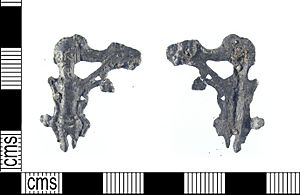Rood of Grace facts for kids
The Rood of Grace was a special crucifix (a statue of Jesus on the cross) kept at Boxley Abbey in Kent, a county in southeast England. This statue was quite unique because it was mechanized. This means it had hidden wires and rods that could make its eyes move, making it seem almost alive!
Many people believed the Rood of Grace was spiritually inspiring. It became a popular place for pilgrimages, where people would travel to visit it. Even a young King Henry VIII visited this famous statue.
Later, during a time called the dissolution of the monasteries (from 1536 to 1541), the Rood of Grace became a topic of debate. This was when King Henry VIII closed down many monasteries and religious houses in England. The Rood was used by some to argue against what they called "superstitious" religious practices in English Catholicism. However, it's also thought that many people at the time might have known it was a mechanical creation, not a truly living thing.
Contents
What Was the Rood of Grace?

The Rood of Grace was a famous religious statue of Jesus on the cross. It was kept at Boxley Abbey, a monastery in Kent, England. Unlike most statues, this one was designed to move. People believed it could shed tears, foam at the mouth, turn its head, nod, and even make different facial expressions.
How Did the Rood Move?
The Rood of Grace was a very clever invention for its time. It used a system of wires and rods, much like a puppet or an early robot, to create its movements. These hidden mechanisms allowed the statue to appear as if it were moving on its own. This made it seem very mysterious and powerful to many who saw it.
A Special Story About Its Arrival
According to an old story, the Rood of Grace arrived at Boxley Abbey in a very unusual way. It was supposedly brought there by a stray horse. The monks at the abbey saw this as a miracle, a sign from God, and decided to keep the crucifix.
A writer named William Lambarde, in his 1570 book Perambulation of Kent, wrote about how the Rood was made. He said it was created by an English carpenter who had been captured by the French. The carpenter supposedly built the Rood to earn his freedom.
The Rood of Grace and the English Reformation
During the 1500s, England went through a major religious change known as the English Reformation. King Henry VIII played a big part in this. He decided to break away from the authority of the Pope and the Roman Catholic Church.
Why Was the Rood Important to the King?
As part of the Reformation, King Henry VIII began the dissolution of the monasteries. This meant he closed down many monasteries and religious houses across England. One reason for this was to increase the money and power of the Crown (the King's government).
The Rood of Grace became a symbol in this process. Critics of the old religious ways used the Rood's mechanical nature to argue that some religious practices were based on "superstition" rather than true faith. They claimed it was a trick to make people believe in miracles. However, as mentioned earlier, some historians believe that many people at the time might have understood that the Rood was a mechanical device, not a truly living one.
What Happened to the Rood?
After the dissolution of Boxley Abbey, the Rood of Grace was taken away. It was publicly shown in London to demonstrate its mechanical parts. This was done to convince people that it was not a miraculous object but a man-made one. The Rood was then destroyed, along with many other religious images and objects during this period of change.
See also
- List of statues of Jesus


